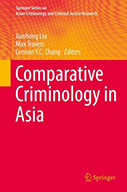Comparative Criminology In Asia

Editors: Jianhong Liu, Max Travers, and Lennon Y.C. Chang
Publisher: Cham, SWIT: Springer International Publishing, 2017. 206p.
Reviewer: Peter Grabosky | January 2019
The academic field of criminology emerged in continental Europe, subsequently spreading across the English Channel, and then to the “new world” beyond. By the 1970s, criminology and its cognate discipline, criminal justice, stimulated by significant increases in reported crime and commensurate investments in the machinery of social control, had become firmly entrenched in North America,
It is said that we now live in The Asian Century. Indeed, few regions of the world are changing as rapidly as Asia. These immense changes, social, political, and economic, have understandably attracted worldwide interest. As Donald Black would remind us, social change produces conflict, which in turn generates crime. It is not surprising, therefore, that crime and criminal policy in Asia have invited the attention of scholars both local and foreign. The time has come to chart a course for the future of criminology in Asia, and this collection edited by Liu, Travers and Chang provides good start.
The book comprises eleven substantive chapters, plus introductory and concluding essays. Collectively, they address a variety of key themes and perspectives. The first pertains to the applicability of criminological theories, developed in “the west,” to Asian settings. Liu’s chapter notes the relative salience of collective identity in Asia, contrasting with western individualism, and suggests that the development of Asia-specific theory may be a useful complement to attempts at universalistic generalization. Carrington discusses the school of “southern criminology,” which might otherwise be called the “criminology of the oppressed.” She notes its relevance to Asia in light of the experience of disadvantaged indigenous peoples, victims of colonial domination and political persecution, and the contemporary Asian underclasses.
Another approach entails focused comparisons of specific institutions in two countries. Daniel Pascoe’s chapter compares the application of capital punishment in Thailand and Singapore, with particular reference to the exercise of clemency. Monica Barry’s contrasts young Japanese offenders’ views of desistance with those of their Scottish counterparts.
Chang’s chapter provides an overview across the Asian Region of one specific issues. Collective responses to cyber crime by members of the Association of South East Asian Nations (ASEAN). Kawamura looks at restorative justice from the reference point of Japan.
Good ethnographic research is relatively rare in “western” criminology, and arguably even moreso in Asia. This may be explained in part by linguistic challenges facing foreign researchers. Julia Wardhaugh’s discussion of the travails of fieldwork in village India is nicely illustrative.
Despite its significant contributions, the book is not without its shortcomings. It is expensive (Hardcover 119,99 €; $149.99), and may not be affordable by the average student. Chapters may be purchased in electronic form for 24,95 € ($29.95). Chapters are of uneven quality, and some have already been published elsewhere. At the same time, a number of eminent scholars of Asian crime and punishment are not among the book’s contributors. The works of Lo, Xu, Zhong, Johnson and Broadhurst, inter alia, are conspicuous in their absence.
It is unfortunate that given the price, the publisher did not invest more in copy-editing. One sentence is seven lines in length. Figures are inconsistently labelled. At least one scholar’s name is misspelled, and the title of one cited work is spelled out differently in the text and in the references—incorrectly in both cases. Lena Zhong was wrongly identified as one “whose graduate training was in the United Kingdom.” This reviewer personally examined Zhong’s PhD thesis for the University of Hong Kong. (Note: It was truly first rate.)
Let us conclude on a positive note. The extent to which Asian criminology is published in western journals has drawn the attention of Professor Setsuo Miyazawa. A concluding chapter by the co-editors has summarized Miyazawa’s findings regarding the underrepresentation (thus far) of Asian content in major English-language journals. This content analysis should continue into the future. One can state with near certainty that the quantity and quality of Asian content will only increase as the Asian Century progresses.
Peter Grabosky, School of Regulation and Global Governance, Australian National University


